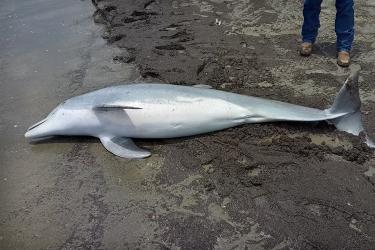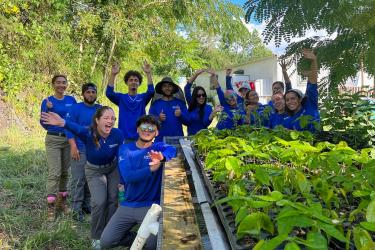Update Week of April 22, 2024
Sawfish rescued April 5th is still in rehabilitation at Mote Marine Laboratory
Receiving treatment 2-3x per week
Treatment consists of visual checks, tube feeding, oral vitamins, blood draws for analyses, etc.
Sawfish seems to be responding well but is still sick
No additional rescues attempted
Sawfish reports were down last week but the weather was also windy so we are unsure if the decrease is associated with weather or an ecological response
Affected sawfish numbers as of April 23, 2024
Affected = 179
Confirmed (recovered) mortalities = 43
April 12, 2024
An endangered smalltooth sawfish is recovering today after being rescued from Cudjoe Key and transported to Mote Marine Laboratory’s facility yesterday. A member of the public reported the animal swimming in circles in Cudjoe Bay. Biologists with the Florida Fish and Wildlife Conservation Commission and Mote Marine Laboratory responded to the distressed sawfish. They completed a quick field assessment that included taking samples, measurements, and tagging, before making the rescue decision. The sawfish was loaded onto a vessel and provided respiratory assistance during the short boat ride to a temporary holding tank.
The sawfish is a 11-foot male. It has been treated and observed around the clock since its rescue on April 5. Veterinarians have provided care and treatment, which will continue for rehabilitation. Once the animal appeared capable of withstanding the nearly 7-hour drive to Mote Marine Lab’s facility, biologists carefully loaded it into a transport trailer operated by Ripley’s Aquariums. Ripley’s Aquariums conservation team monitored the sawfish and water quality conditions throughout the trip to the facility.
Now at Mote, scientists will continue to monitor and treat the sawfish. We hope it will be fully rehabilitated and returned to the wild. We are excited about the successful steps to date in rescuing endangered smalltooth sawfish and look forward to building upon lessons learned.
The team continues to monitor the sawfish hotline for additional rescue opportunities. Florida Fish and Wildlife Conservation Commission has responded to dozens of reports over the last 2 months. They have provided aid and collected samples when possible, as well as performing necropsies on dead sawfish. With this first rescue success, we are hopeful to rescue additional sawfish while continuing to provide aid to others in the wild. If you see a sawfish in distress, call (844) 4-SAWFISH) or email Sawfish@myfwc.com.
March 27, 2024: An Attempt to Rescue Sick Sawfish
Next week, NOAA Fisheries will initiate an emergency response effort with partners to attempt to rescue and rehabilitate smalltooth sawfish affected by this mortality event. We hope to prevent additional losses of this endangered species.
An effort of this kind has never been done before in the United States. The logistics are complex.
“If the opportunity presents itself, this would be the first attempt ever to rescue and rehabilitate smalltooth sawfish from the wild,” said Adam Brame, NOAA Fisheries’ sawfish recovery coordinator. “We’re hopeful for positive outcomes from these rescue attempts, and grateful to our partners for their support as we work to protect this endangered species.”
“It’s important to note that active rescue and rehabilitation are not always effective in saving stranded animals. However, it can still give us critical information to learn about the nature of the distress,” he added.
Understanding the Response Effort
Background
The Florida Fish and Wildlife Conservation Commission is documenting reports of abnormal fish behavior, including spinning, in the Lower Florida Keys. Along with this abnormal behavior, there have also been reports of fish deaths in these areas, including more than 38 smalltooth sawfish as of April 11. The Commission is leading an effort to investigate the abnormal behavior and cause of death. NOAA Fisheries is leading the rescue effort.
Why is rescue and rehabilitation necessary?
The smalltooth sawfish was the first marine fish to receive federal protection as an endangered species under the Endangered Species Act in 2003. They were historically found in coastal waters from Texas to North Carolina, but now generally only found in Florida.
As of April 11, we have 38 documented sawfish deaths. Affected sawfish have been large juveniles and adults (7–14 feet in length).
“We suspect that total mortalities are greater, since sawfish are negatively buoyant and thus unlikely to float after death,” said Brame. “Given the limited population size of smalltooth sawfish, the mortality of at least two dozen sawfish could have an impact on the recovery of this species.”
Who is participating?
- NOAA Fisheries
- Florida Fish and Wildlife Conservation Commission
- Havenworth Coastal Conservation
- Ripley’s Aquariums
- Mote Marine Laboratory
- Dynasty Marine Associates, Inc.
What is the care plan for rehabilitation?
Veterinarians and scientists are working to better understand the cause of these issues and will develop specific care guidelines as we learn more. We will work directly with the animal care teams. The rescued sawfish will be under constant observation at quarantine facilities. With the aid of the Smalltooth Sawfish Recovery Implementation Team and partners, we will make the final decision about an animal’s rehabilitation status. “Our goal is to release all rescued sawfish back to the wild once rehabilitated,” said Brame.





